|






|
|
About
|
The Republic of Poland
(Polish: Rzeczpospolita Polska) is a country located in Central
Europe, between Germany to the west, the Czech Republic and
Slovakia to the south, Ukraine and Belarus to the east, and the
Baltic Sea, Lithuania, and Russia (in the form of the
Kaliningrad Oblast exclave) to the north.
The Polish state was formed over 1,000 years ago under the Piast
dynasty, and reached its golden age near the end of the 16th
century under the Jagiellonian dynasty, when Poland was one of
the largest, wealthiest, and most powerful countries in Europe.
In 1791 the Sejm of the Polish-Lithuanian Commonwealth adopted
the Constitution of May 3, Europe's first modern codified
constitution, and the second in the world after the Constitution
of the United States. Soon afterwards, the country ceased to
exist after being partitioned by its neighbours Russia, Austria,
and Prussia. It regained independence in 1918 in the aftermath
of the First World War as the Second Polish Republic. Following
the Second World War it became a communist satellite state of
the Soviet Union known as the People's Republic of Poland. In
1989 the first partially-free elections in Poland's post-World
War II history concluded the Solidarity (Solidarność) movement's
struggle for freedom and resulted in the defeat of Poland's
communist rulers. The current Third Polish Republic was
established, followed a few years later by the drafting of a new
constitution in 1997. In 1999 Poland acceded to NATO, and in
2004 it joined the European Union. |

|
Capital |
Warsaw |
|
Official language |
Polish |
|
Government |
|
President |
Lech Kaczyński |
|
Prime minister |
Kazimierz
Marcinkiewicz |
|
Independence |
|
• Christianisation Date |
966 |
|
• Declared |
10th century |
|
• Redeclared |
November 11, 1918
|
|
Area |
|
• Total |
312,685 km²
(68th) |
|
• Water (%) |
2.6% |
|
Population |
|
• 2005 est. |
38,635,144 (32nd) |
|
• 2002 census |
38,230,080 |
|
• Density |
123.5/km² (64th) |
|
Currency |
Złoty (PLN)
|
|
Time zone |
(DST) CET (UTC+1) |
|
• Summer |
CEST (UTC+2)
|
|
Internet TLD |
.pl (also .eu as
part of the European Union) |
|
Calling code |
+48 |
- Up -
History
|
Poland began to form
into a recognizable unitary and territorial entity around the
middle of the 10th century under the Piast dynasty. Poland's
first historically documented ruler, Mieszko I, was baptized in
966, adopting Catholic Christianity as the country's new
official religion, to which the bulk of the population converted
in the course of the next century. In the 12th century Poland
fragmented into several smaller states, which were later ravaged
by the Mongol armies of the Golden Horde in 1241. In 1320
Władysław I became the King of the reunified Poland. His son
Kazimierz Wielki repaired the Polish economy, built new castles
and won the war against the Russian dukedom (Lwów became a
Polish City).
Luckily, the Black Death which affected most parts of Europe
from 1347 to 1351 did not come to Poland: "One of the greatest
calamities in European history began in 1347 when bubonic plague
struck, brought to Italy, it is thought, by a group of Genoese
returning home through Sicily and Pisa from Kaffa in the Crimea.
Their fortress there had been besieged by Mongol invaders who
had suddenly begun to die of a disease that caused black,
blood-oozing swellings and immense pain....By 1351, it had
spread over most of Europe. The only areas which escaped were
Milan, Poland, Belgium, eastern Germany and part of southwest
France." (Page 235 of "Timelines of World History" by John B.
Teeple, ISBN 0-7894-8926-0 www.dk.com Dorling Kindersley).
Under the Jagiellon dynasty, Poland forged an alliance with its
neighbour Lithuania. A golden age occurred in the 16th century
during its union (Lublin Union) with Lithuania in the
Polish-Lithuanian Commonwealth. The citizens of Poland took
pride in their ancient freedoms and Sejm parliamentary system,
although the szlachta monopolised most of the benefits as most
of Poles since the middle of the fourteenth century were serfs.
Landowners gained almost unlimited ownership over serfs. Since
that time Poles have regarded freedom as their most important
value. Poles often call themselves the nation of the free people.
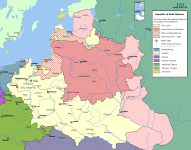 In
the mid-17th century a Swedish invasion rolled through the
country in the turbulent time known as "The Deluge" (potop).
Numerous wars against the Ottoman Empire, Russia, Cossacks,
Transylvania and Brandenburg-Prussia ultimately came to an end
in 1699. During the following 80 years, the waning of the
central government and deadlock of the institutions weakened the
nation, leading to anarchistic tendencies and a growing
dependency on Russia. In Polish Democracy every member of
parliament was able to break any work or project by shouting
'Liberum Veto' during the session. Russian tsars took advantage
of this unique political vulnerability by offering money to
Parliamentary traitors, who in turn would consistently and
subversively block necessary reforms and new solutions. In
the mid-17th century a Swedish invasion rolled through the
country in the turbulent time known as "The Deluge" (potop).
Numerous wars against the Ottoman Empire, Russia, Cossacks,
Transylvania and Brandenburg-Prussia ultimately came to an end
in 1699. During the following 80 years, the waning of the
central government and deadlock of the institutions weakened the
nation, leading to anarchistic tendencies and a growing
dependency on Russia. In Polish Democracy every member of
parliament was able to break any work or project by shouting
'Liberum Veto' during the session. Russian tsars took advantage
of this unique political vulnerability by offering money to
Parliamentary traitors, who in turn would consistently and
subversively block necessary reforms and new solutions.
The Enlightenment in Poland fostered a growing national movement
to repair the state, resulting in what is claimed to be the
first modern written constitution in Europe, the Constitution of
May 3 in 1791. The process of reforms ceased with the partitions
of Poland between Russia, Prussia, and Austria in 1772, 1793 and
1795 which ultimately dissolved the country. Poles resented
their shrinking freedoms and several times rebelled against
their oppressors (see List of Polish Uprisings).
Napoleon recreated a Polish state, the Duchy of Warsaw, but
after the Napoleonic wars, Poland was split again by the Allies
at the Congress of Vienna. The eastern part was ruled by the
Russian tsar as a Congress Kingdom, and possessed a liberal
constitution. However, the tsars soon reduced Polish freedoms
and Russia eventually de facto annexed the country. Later in the
19th century, Austrian-ruled Galicia became the oasis of Polish
freedom.
During World War I all the Allies agreed on the restitution of
Poland that United States President Woodrow Wilson proclaimed in
point 13 of his Fourteen Points. Shortly after the surrender of
Germany in November 1918, Poland regained its independence as
the Second Polish Republic (II Rzeczpospolita Polska). It was
established after a series of military conflicts, like the
1919-1921 Polish-Soviet War.
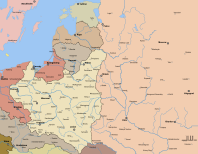 The
1926 May Coup of Józef Piłsudski turned the Second Polish
Republic into Sanacja that lasted until the start of World War
II when Germany and the Soviet Union invaded Poland. Warsaw
surrendered on September 28, 1939. The eastern part of the
German occupied zone was transformed into the General Government
area, and the western part was just incorporated to German
Reich. The
1926 May Coup of Józef Piłsudski turned the Second Polish
Republic into Sanacja that lasted until the start of World War
II when Germany and the Soviet Union invaded Poland. Warsaw
surrendered on September 28, 1939. The eastern part of the
German occupied zone was transformed into the General Government
area, and the western part was just incorporated to German
Reich.
Of all the countries involved in the war, Poland lost the
highest percentage of its citizens: over 6 million perished,
half of them Polish Jews. At its conclusion, Poland's borders
were shifted westwards, pushing the eastern border to the Curzon
line, even though the defense of Poland was the reason that
France and the United Kingdom had declared war on Germany. The
second aggressor, the Soviet Union, was given the right to
occupy former Polish territory in negotiations, which means that
the Molotov-Ribbentrop Pact was partially confirmed.
On the other hand, the western border of Poland was moved to the
Oder-Neisse line. After the shift, Poland emerged 20% smaller by
77,500 km² (29,900 mi²); although the important cities of Gdańsk
(Danzig), Szczecin (Stettin) and Wrocław (Breslau) were all
incorporated into its post-war borders. The shift forced the
migration of millions of people – Poles, Germans, Ukrainians,
Jews.
As a result of these events, Poland became, for the first time
in history, an ethnically unified country. A Polish minority is
still present in neighbouring countries of Ukraine, Belarus and
Lithuania, as well as in other countries (see Poles article for
the population numbers). The largest number of ethnic Poles
outside of the country can be found in the United States.
The Soviet Union instituted a new communist government in Poland,
analogous to much of the rest of the Eastern Bloc. Military
alignment within the Warsaw Pact throughout the Cold War was
also part of this change. In 1948 a turn towards Stalinism
brought in the beginning of the next period of totalitarian rule.
The People's Republic of Poland (Polska Rzeczpospolita Ludowa)
was officially proclaimed in 1952. In 1956 the régime became
more liberal, freeing many people from prison and expanding some
personal freedoms. In 1970 the government was changed. It was a
time when the economy was more modern, and the government had
large credits. Labour turmoil in 1980 led to the formation of
the independent trade union, "Solidarity", which over time
became a political force. It eroded the dominance of the
Communist Party; by 1989 it had triumphed in parliamentary
elections, and Lech Wałęsa, a Solidarity candidate, eventually
won the presidency in 1990. The Solidarity movement greatly
contributed to the soon-following collapse of Communism all over
Eastern Europe.
A shock therapy program during the early 1990s enabled the
country to transform its economy into one of the most robust in
Central Europe. Despite a temporary slump in social and economic
standards, there were numerous improvements in other human
rights (free speech, functioning democracy and the like). Poland
was the first post-communist country to regain pre-1989 GDP
levels. Poland joined the NATO alliance in 1999 along with the
Czech Republic and Hungary. Polish voters then said yes to the
EU in a referendum in June 2003. Poland joined the European
Union on 1 May 2004. |
- Up -
Culture
|
The style and
personality of Polish life has been shaped over a thousand years.
The national culture developed at the crossroads of the Latinate
and Byzantine worlds, in continual dialogue with the many ethnic
groups in Poland. The people of Poland have always been
hospitable to artists from abroad, and eager to follow what was
happening in other countries. In the 19th and 20th centuries
Poles' concentration on cultural advancement often took the
place of political and economic activity. These factors have
contributed to the versatile character of Polish art, with all
its complex nuances.
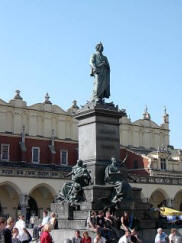 Dialogue
and the interpenetration of cultures have been major
characteristics of Polish tradition for centuries. Customs,
manners, and dress have reflected the influences of east and
west. The traditional costumes worn by the gentry in the 16th
and 17th centuries were inspired by rich eastern ornamental
styles, including Islamic influences. Polish cuisine and social
customs are another reflection of multifarious trends. Dialogue
and the interpenetration of cultures have been major
characteristics of Polish tradition for centuries. Customs,
manners, and dress have reflected the influences of east and
west. The traditional costumes worn by the gentry in the 16th
and 17th centuries were inspired by rich eastern ornamental
styles, including Islamic influences. Polish cuisine and social
customs are another reflection of multifarious trends.
Polish towns reflect the whole spectrum of European styles.
Poland's eastern frontiers marked the boundary of the influences
of Western architecture on the continent. History has not been
kind to Poland's architectural monuments. However, a number of
ancient edifices have survived: castles, churches, and stately
homes, sometimes unique in the regional or European context.
Some of them have been painstakingly restored (the Wawel), or
completely reconstructed after totally devastation in the Second
World War (the Old Town and Royal Castle in Warsaw, the Old
Towns of Gdańsk and Wrocław). Kazimierz on the Vistula is an
example of a well-preserved medieval town. Kraków ranks among
the best preserved Gothic and Renaissance urban complexes in
Europe. In Vilnus (since 1945 outside the country) are being
found about 40 baroque and Renaissance churches. In Lviv (since
1945 outside the country) are being found Gothic, Renaissance,
and baroque urban complex with influence of the orthodox and
armenian church. Polish church architecture deserves special
attention. Some interesting buildings were also constructed
during the Communist regime in the style of Socialist Realism.
Recently, some remarkable specimens of modern architecture have
been erected.
Polish art has always reflected world trends while maintaining
its unique character. Jan Matejko's famous school of Historicist
painting produced monumental portrayals of significant events in
Polish history. Stanisław Witkiewicz was an ardent supporter of
Realism in Polish art, its main representative being Jozef
Chełmoński. The Młoda Polska (Young Poland) movement witnessed
the birth of modern Polish art, and engaged in a great deal of
formal experimentation. Its main adherents were Jacek Malczewski
(Symbolism), Stanisław Wyspiański, Józef Mehoffer, and a group
of Polish Impressionists. Artists of the twentieth-century
Avant-Garde represented various schools and trends. The art of
Tadeusz Makowski was influenced by Cubism; while Władysław
Strzemiński and Henryk Stażewski worked within the
Constructivist idiom. Distinguished contemporary artists include
Roman Opałka, Leon Tarasewicz, Jerzy Nowosielski, and Mirosław
Bałka and Katarzyna Kozyra in the younger generation. The most
celebrated Polish sculptors include Xawery Dunikowski, Katarzyna
Kobro, Alina Szapocznikow and Magdalena Abakanowicz. Since the
inter-war years, Polish art and documentary photography has
enjoyed worldwide recognition. In the sixties the Polish Poster
School was formed, with Henryk Tomaszewski and Waldemar Świerzy
at its head.
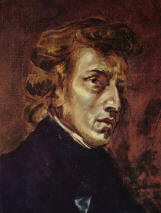 The
origins of Polish literature written in the Polish vernacular go
back beyond the 14th century. In the 16th century the poetic
works of Jan Kochanowski established him as a leading
representative of European Renaissance literature. Baroque and
Neo-Classicist letters made a signal contribution to the
cementing together of Poland's peoples of many different
cultural backgrounds. The early 19th century novel "Manuscrit
trouvé à Saragosse" by Count Jan Potocki, which survived in its
Polish translation after the loss of the original in French,
became a world classic. Wojciech Has' film based on it, a
favourite with Luis Bunuel, later became a cult film on
university campuses. Poland's great Romantic literature
flourished in the 19th century when the country had lost its
independence. The poets Adam Mickiewicz, Juliusz Słowacki and
Zygmunt Krasiński, the "Three Bards," became the spiritual
leaders of a nation deprived of its sovereignty, and prophesied
its revival. The novelist Henryk Sienkiewicz, who on the Nobel
Prize in 1905, eulogised the historical tradition. The
origins of Polish literature written in the Polish vernacular go
back beyond the 14th century. In the 16th century the poetic
works of Jan Kochanowski established him as a leading
representative of European Renaissance literature. Baroque and
Neo-Classicist letters made a signal contribution to the
cementing together of Poland's peoples of many different
cultural backgrounds. The early 19th century novel "Manuscrit
trouvé à Saragosse" by Count Jan Potocki, which survived in its
Polish translation after the loss of the original in French,
became a world classic. Wojciech Has' film based on it, a
favourite with Luis Bunuel, later became a cult film on
university campuses. Poland's great Romantic literature
flourished in the 19th century when the country had lost its
independence. The poets Adam Mickiewicz, Juliusz Słowacki and
Zygmunt Krasiński, the "Three Bards," became the spiritual
leaders of a nation deprived of its sovereignty, and prophesied
its revival. The novelist Henryk Sienkiewicz, who on the Nobel
Prize in 1905, eulogised the historical tradition.
In the early 20th century many outstanding literary works
emerged from exchange across cultures and Avant-Garde
experimentation. The legacy of the Kresy Marchlands in Poland's
eastern regions with Wilno and Lwów (now Vilnius and Lviv) as
two major centres for the arts, played a special role in these
developments. This was also a region in which Jewish tradition
and the mystic movement of Hasidism thrived. The Kresy were a
cultural trysting-place for numerous ethnic and national groups,
where the arts flourished of cultures in contact with each other.
The works of Bruno Schulz, Bolesław Leśmian, and Józef
Czechowicz were written here. In the south of Poland, Zakopane
was the birthplace of the avant-garde works of Stanisław Ignacy
Witkiewicz (Witkacy).
After the Second World War many Polish writers found themselves
in exile abroad, with many clustered around the Paris-based
Kultura publishing venture run by Jerzy Giedroyc. The group of
emigre writers included Witold Gombrowicz, Gustaw
Herling-Grudziński, Czesław Miłosz, and Sławomir Mrożek.
Zbigniew Herbert, Tadeusz Różewicz, Czesław Miłosz (Nobel Prize
in 1980), and Wisława Szymborska (Nobel Prize in 1996) are among
the most outstanding 20th century Polish poets, novelists and
playwrights, which also includes Witold Gombrowicz, Sławomir
Mrożek, and Stanisław Lem (for science fiction). Hanna Krall's
reportage which focuses mainly on the war-time Jewish experience,
and Ryszard Kapuściński's books have been translated into many
languages.
It is difficult to grasp fully the detailed tradition of Polish
Romanticism and its consequences for Polish literature without a
thorough knowledge of Polish history. The music of Fryderyk
Chopin, inspired by Polish tradition and folklore, conveys the
quintessence of Romanticism. Since 1927, the Chopin
International Piano Competition, one of the world's most
prestigious piano competitions, has been held every five years
in Warsaw. Traditional Polish music has inspired composers like
Karol Szymanowski, Mieczysław Karłowicz, Witold Lutosławski,
Wojciech Kilar, Henryk Mikołaj Górecki, and Krzysztof Penderecki
- all of whom rank among the world's most celebrated composers.
Contemporary Polish jazz with its special national flavour has
fans and followers in many countries. The best-known jazzmen are
Krzysztof Komeda, Michał Urbaniak, Adam Makowicz, and Tomasz
Stańko. Successful composers of film music include Zbigniew
Preisner, Jan A.P. Kaczmarek, and Wojciech Kilar.
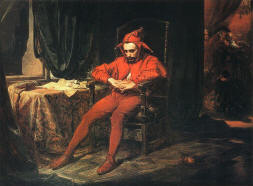 Graduates
of the famous Łódź Film School include many celebrated directors,
among them Roman Polański ("Knife in the Water", "Rosemary's
Baby", "Frantic", "The Pianist") and Krzysztof Zanussi, a
leading director of the cinema of moral anxiety of the 70s.
Andrzej Wajda's films offer an insightful analysis of what is
universal in the Polish experience - the struggle to maintain
human dignity under circumstances which hardly allow it. His
major films describe the identity of many of Poland's
generations. In 2000 Wajda was awarded an Oscar for his
contribution to cinema. In the 90s Krzysztof Kieślowski's films,
such as "The Decalogue", "The Double Life of Veronica", "Three
Colors", won great popularity. Other Polish film directors such
as Agnieszka Holland and Jerzy Kamiński have worked in Hollywood
as well. Polish animated films - represented by Jan Lenica and
Zbigniew Rybczyński (awarded an Oscar in 1983) - have a long
tradition, and derivie inspiration from Poland's graphic arts. Graduates
of the famous Łódź Film School include many celebrated directors,
among them Roman Polański ("Knife in the Water", "Rosemary's
Baby", "Frantic", "The Pianist") and Krzysztof Zanussi, a
leading director of the cinema of moral anxiety of the 70s.
Andrzej Wajda's films offer an insightful analysis of what is
universal in the Polish experience - the struggle to maintain
human dignity under circumstances which hardly allow it. His
major films describe the identity of many of Poland's
generations. In 2000 Wajda was awarded an Oscar for his
contribution to cinema. In the 90s Krzysztof Kieślowski's films,
such as "The Decalogue", "The Double Life of Veronica", "Three
Colors", won great popularity. Other Polish film directors such
as Agnieszka Holland and Jerzy Kamiński have worked in Hollywood
as well. Polish animated films - represented by Jan Lenica and
Zbigniew Rybczyński (awarded an Oscar in 1983) - have a long
tradition, and derivie inspiration from Poland's graphic arts.
The Polish avant-garde theatre is world-famous, with Jerzy
Grotowski as its most innovative and creative representative.
One of the most original twentieth-century theatre personalities
was Tadeusz Kantor, painter, theoretician of drama, stage
designer, and playwright, his ideas finding their culmination in
the theatre of death and his most recognised production being
"Umarła klasa" (Dead Class).
Poland offers a wide spectrum of cultural experience. Those
interested in high culture will enjoy the renowned music
festivals like Wratislavia Cantans and the Warsaw Autumn. Polish
museums exhibit remarkable art collections - masterpieces
including Leonardo da Vinci's Lady with an Ermine in the
Czartoryski Museum, Kraków; the Veit Stoss High Altar in St.
Mary's Basilica, Kraków; and the Last Judgement by Hans Memling
(The National Museum in Gdańsk). Ethnographic museums and
open-air museums also hold attractive collections. The panorama
of Polish culture is completed by a medley of local festivals. |
- Up -
|

 In
the mid-17th century a Swedish invasion rolled through the
country in the turbulent time known as "The Deluge" (potop).
Numerous wars against the Ottoman Empire, Russia, Cossacks,
Transylvania and Brandenburg-Prussia ultimately came to an end
in 1699. During the following 80 years, the waning of the
central government and deadlock of the institutions weakened the
nation, leading to anarchistic tendencies and a growing
dependency on Russia. In Polish Democracy every member of
parliament was able to break any work or project by shouting
'Liberum Veto' during the session. Russian tsars took advantage
of this unique political vulnerability by offering money to
Parliamentary traitors, who in turn would consistently and
subversively block necessary reforms and new solutions.
In
the mid-17th century a Swedish invasion rolled through the
country in the turbulent time known as "The Deluge" (potop).
Numerous wars against the Ottoman Empire, Russia, Cossacks,
Transylvania and Brandenburg-Prussia ultimately came to an end
in 1699. During the following 80 years, the waning of the
central government and deadlock of the institutions weakened the
nation, leading to anarchistic tendencies and a growing
dependency on Russia. In Polish Democracy every member of
parliament was able to break any work or project by shouting
'Liberum Veto' during the session. Russian tsars took advantage
of this unique political vulnerability by offering money to
Parliamentary traitors, who in turn would consistently and
subversively block necessary reforms and new solutions. The
1926 May Coup of Józef Piłsudski turned the Second Polish
Republic into Sanacja that lasted until the start of World War
II when Germany and the Soviet Union invaded Poland. Warsaw
surrendered on September 28, 1939. The eastern part of the
German occupied zone was transformed into the General Government
area, and the western part was just incorporated to German
Reich.
The
1926 May Coup of Józef Piłsudski turned the Second Polish
Republic into Sanacja that lasted until the start of World War
II when Germany and the Soviet Union invaded Poland. Warsaw
surrendered on September 28, 1939. The eastern part of the
German occupied zone was transformed into the General Government
area, and the western part was just incorporated to German
Reich. Dialogue
and the interpenetration of cultures have been major
characteristics of Polish tradition for centuries. Customs,
manners, and dress have reflected the influences of east and
west. The traditional costumes worn by the gentry in the 16th
and 17th centuries were inspired by rich eastern ornamental
styles, including Islamic influences. Polish cuisine and social
customs are another reflection of multifarious trends.
Dialogue
and the interpenetration of cultures have been major
characteristics of Polish tradition for centuries. Customs,
manners, and dress have reflected the influences of east and
west. The traditional costumes worn by the gentry in the 16th
and 17th centuries were inspired by rich eastern ornamental
styles, including Islamic influences. Polish cuisine and social
customs are another reflection of multifarious trends. The
origins of Polish literature written in the Polish vernacular go
back beyond the 14th century. In the 16th century the poetic
works of Jan Kochanowski established him as a leading
representative of European Renaissance literature. Baroque and
Neo-Classicist letters made a signal contribution to the
cementing together of Poland's peoples of many different
cultural backgrounds. The early 19th century novel "Manuscrit
trouvé à Saragosse" by Count Jan Potocki, which survived in its
Polish translation after the loss of the original in French,
became a world classic. Wojciech Has' film based on it, a
favourite with Luis Bunuel, later became a cult film on
university campuses. Poland's great Romantic literature
flourished in the 19th century when the country had lost its
independence. The poets Adam Mickiewicz, Juliusz Słowacki and
Zygmunt Krasiński, the "Three Bards," became the spiritual
leaders of a nation deprived of its sovereignty, and prophesied
its revival. The novelist Henryk Sienkiewicz, who on the Nobel
Prize in 1905, eulogised the historical tradition.
The
origins of Polish literature written in the Polish vernacular go
back beyond the 14th century. In the 16th century the poetic
works of Jan Kochanowski established him as a leading
representative of European Renaissance literature. Baroque and
Neo-Classicist letters made a signal contribution to the
cementing together of Poland's peoples of many different
cultural backgrounds. The early 19th century novel "Manuscrit
trouvé à Saragosse" by Count Jan Potocki, which survived in its
Polish translation after the loss of the original in French,
became a world classic. Wojciech Has' film based on it, a
favourite with Luis Bunuel, later became a cult film on
university campuses. Poland's great Romantic literature
flourished in the 19th century when the country had lost its
independence. The poets Adam Mickiewicz, Juliusz Słowacki and
Zygmunt Krasiński, the "Three Bards," became the spiritual
leaders of a nation deprived of its sovereignty, and prophesied
its revival. The novelist Henryk Sienkiewicz, who on the Nobel
Prize in 1905, eulogised the historical tradition.